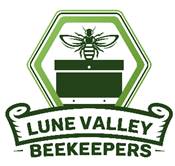What is honey?
All honey begins with nectar. Bees collect nectar, a very weak solution of complex sugars from flowers and trees, and store it in their honey stomachs. Whilst there, it is mixed with a number of different enzymes which convert the complex sugars in nectar into more simple sugars.
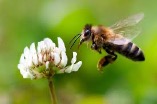
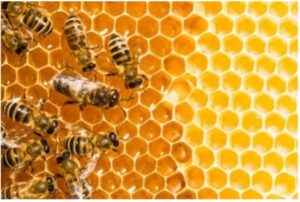
Once back at their hive the bees store the mixture in their honey comb and then start to reduce the moisture content to anything between 16% and 20%. Once this is achieved, they seal the honey in the comb with a thin wax capping. Sealed honey will last indefinitely. Some has even been found in Egyptian pyramids and still perfectly edible after over 4000 years!
The bees use their honey in two ways. One is to mix it with pollen to create “bee bread”, a mixture that they use to feed their larvae, and the other is for feed for themselves during winter and other times of nectar shortage.
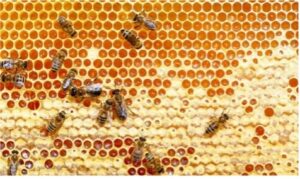

Harvesting honey
A frame of honey ready for harvesting looks like this.
There are two approaches to harvesting honey, the most widespread approach is to use a centrifugal extractor. Firstly, the wax capping is removed using either a sharp or a heated knife. The frames of uncapped honey are then placed into a centrifuge, and spun round until the honey is extracted from the frames and flows out to be collected.
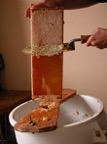
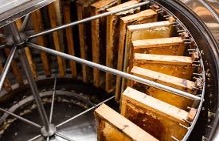
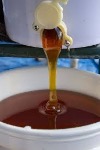
Many commercial honey extractors heat the honey somewhat in order to make it run easier. However, heating honey above 36C destroys many of the beneficial ingredients within the honey. They also finely filter the honey. Whilst this ensures that it is very clear once in the jar, this filtering removes pollen grains, the ingredient which many hay fever sufferers believe gives them relief.
The second approach is to mash the frames of honey and allow the mixture to settle. Most of the honey will sink to the bottom of the container and the wax will float on top. The wax is then pressed to remove any honey remaining in it.
Set honey (Granulation)
All pure honey will granulate or become solid in cool weather, and this condition is, in fact, the best proof of its quality. It can easily be restored to the liquid state by gently warming it by standing the jar in warm water until it becomes liquid again. Heating honey to over 36C destroys most of the beneficial ingredients within the honey.
Medical purposes
Evidence from Stone Age paintings shows treatment of disease with bee product such as honey originated some 8000 years ago. Ancient scrolls, tablets and books, such as Sumerian clay tablets (6200 BC), Egyptian papyri (1900–1250 BC), Veda (Hindu scripture) 5000 years, Holy Koran, Bible, and Hippocrates (460–357 BC) illustrated that honey had been widely used as a drug. It continues to be used to this day and there is medical research to show that it can be beneficial in the treatment of wounds, diabetes, some cancers, asthma, hay fever, cardiovascular, neurological and gastrointestinal diseases.
However, occasionally, honey contains bacteria that can produce toxins in a baby’s intestines, leading to infant botulism, which is a very serious illness. Do not give honey to children until they are over 1 year old.
Honey fraud
Honey is defined as “the natural sweet substance produced by bees from the nectar or secretions of plants, and stored in honeycombs to ripen and mature.”
However, honey fraud, that is the dilution of honey with inexpensive sugar syrups such as those from sugar cane, maize, sugar beet and rice, is widespread though mainly with cheap, imported honey. The dilution of expensive honeys, such as Manuka, is also common.
You are recommended to carefully read the label on the jar!
Raw honey
The term “raw honey” is increasingly being used by some honey producers. Although the term has no legal standing, it is usually regarded as meaning that the honey has only been coarse filtered once, to remove debris such as bits of dead bee etc and that the honey has not been heated above 36C. Most commercial producers heat their honey to higher temperatures in order to speed up the bottling process!
All honey from Lune Valley Beekeepers is pure honey, directly from our hives, that has only been coarse filtered.
